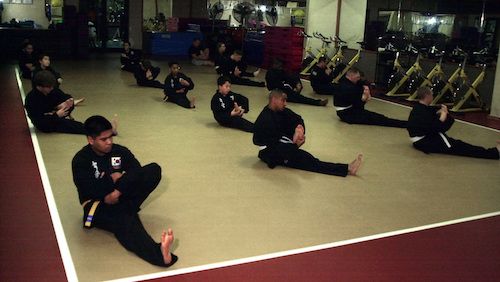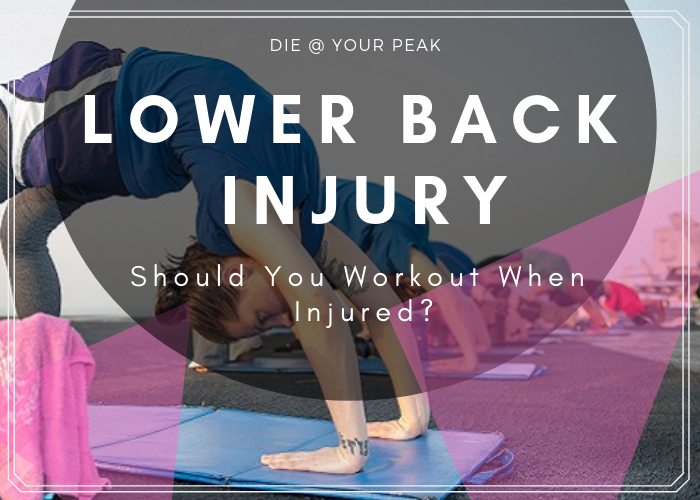Not too long ago, for one of our daily WOD + strength workouts at our CrossFit gym, we started off the strength portion of the workout with a 5×5 squat. After a brief warm up of 2-3 sets of 135 pounds, I felt that I was ready to begin increasing the weight. At around 205 lbs. at the bottom of the descent of the squat, I felt a sudden pain on the lower back. It was an acute pain and caused my legs to weaken and give out. Luckily, I was able to bail out and dropped the barbell behind me.
After about an hour, I was able to slowly get up with assistance and “walk it off”. The next couple of days would be very difficult in terms of just getting out of bed. After 7 days of the injury, I was still having issues sitting up without pain.
This acute injury was caused by my impatience to not warm up properly as well as increase weight too quickly. When faced with an injury like this, there’s a few things to keep in mind during your recovery.
Evaluate the Seriousness of the Injury
Serious injuries need medical attention before you develop an action plan moving forward. For precaution, you should get your injury examined by a doctor just in case the injury is serious. A proper diagnosis of your injury can help point you to the right direction on certain exercises and rehabilitation routines to look into.
Since I’m pretty sensitive to abnormalities in my body, I didn’t think it was anything serious. I’m no expert but I’ve had similar injuries in the past and knew how it felt and how long it would take before I was back up and running.
Don’t Let the Injury Be an Excuse for Inactivity

As somebody who likes to train everyday, I typically won’t let an injury be an excuse for inactivity. I rested in bed the entire day and evening I first got my lower back injury, but after that I was back to the gym.
If it’s already hard for you to get to the gym, an injury will give you another excuse not to train. Don’t let this happen. Think of the injury as a sign of what you need to work on in the future. Get creative on ways to trains and how you can improve yourself so injuries like this are less likely to occur. Just because you’re injured doesn’t mean you shouldn’t be working on flexibility, mobility or strength of another body part that isn’t injured.
Nutrition, Rest And Recover

I was injured around noon on a Friday. By evening, I was still in pain but was contemplating going out and having a few drinks. I thought, “maybe this will help numb the pain”. I decided not to because of my injury and instead get a few extra hours of good quality sleep. I ate a healthy, low inflammation meal and slept early that night.
In the past, I would tough it out, drink and party even with injuries or colds. Even though the distraction plus the alcohol would numb the pain, this never seemed to help with recovery and I would wake up regretting it.
Nowadays I value the time I feel healthy and get to train and want to shorten the recovery process as much as I can. One of the best ways to do this is to properly rest and to make sure resources are allocated to helping you properly heal and not allocated to hangover recovery duties.
Step up Your Mobility and Stretching Routines

Most people don’t spend enough time working on flexibility and mobility, yet most movements and exercises can be improved by improving your mobility.
Use the time you have out of the gym to work on mobility and flexibility. Stretching and massaging areas around the injured body part can help relieve pain and get blood flowing to the affected area.
A good YouTube channel to follow is Kelly
Here are links to MobilityWod’s YouTube channel and website
Find a Workout Routine That Doesn’t Hurt

Even with an injury, you can still perform exercises that don’t affect the injured area. If you have shoulder injuries, you can focus on lower body or specific pulling exercises that might not hurt your shoulders. I had lower back pain after the injury, but I was able to work on upper body exercises like weighted pull-up and bench pressing.
Injuries can give you the opportunity to work on other muscle groups that you may have been neglecting.
Slowly Introduce Exercises to Rehab Injured Area
At a certain point, you should begin introducing exercises to the injured area. The exercises should be mild and not cause you excruciating pain but should stress the injured area a bit. For my lower back injury, as soon as I was able to, I was performing body weight squats and lunges, slowly and carefully.
Getting some blood flowing to the affected region and movement of the affected area in conjunction with my body’s natural healing process has been the quickest way for me to recover.
How to Prevent Injuries In the First Place
Preventing injuries can be difficult because as an athlete or an active individual, you are continually testing yourself and pushing yourself to your physical and mental limits. Be too cautious, and you might never know what you are capable of. Push yourself too hard, and you risk the chance of a debilitating injury that can prevent you from training or worse.
To limit the risk of injury, be patient and try progressing at a pace you find reasonable when increasing weights or learning new skills.
Make sure you spend a good time comprehensively warming up your body and moving your joints. Here are 10 of the best mobility and flexibility drills from one of the more respected fitness video blogs, AthleanX.
After you spent some time warming up, you should also warm up the specific movement you are going to be practicing. If you are squatting, start with bodyweight squats then progressively move up in weight. This was what I failed to do during my warm up process. Because I jumped up in weight too quickly, my body wasn’t warm enough to handle the load. I went from 135 pounds to 205 in 3 short sets. I should have done a few more sets of 135 lbs before moving up. I wasn’t patient enough was in a rush to get close to my max squat weight.
It’s also important to make sure you hold a tight core and keep your lumbar spinal area stiff when performing heavy loaded movements, especially when it involves your lower back and hips.
Because of my impatience and lack of focus of the fundamentals during my squat session, it will take a while before I even attempt a max back squat. When I do get back, I will remember to focus on the fundamentals, form and warm up properly for lifts that can be potentially dangerous.
